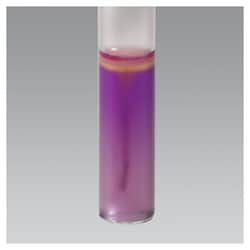R061366
Thermo Scientific™ MIO Medium
Manufacturer: Fischer Scientific
The price for this product is unavailable. Please request a quote
Certifications/Compliance
Industrial Reference: BAM.
Format
15mm x 103mm Tube
Quantity
20 x 5 mL
Description
MIO Medium (Motility Indole Ornithine Medium)
Product Type
Microbiology Media
Description
- Differentiate enteric gram-negative bacilli on the basis of motility, production of indole, and ornithine decarboxylase with Thermo Scientific™ Remel™ MIO Medium (Motility Indole Ornithine Medium)
- In 1970, Ederer and Clark developed MIO Medium (Motility Indole Ornithine Medium) to identify enteric gram-negative bacilli 1
- MIO Medium combines three test into a single tube to facilitate inoculation and identification of Enterobacteriaciae
- Oberhofer and Hajkowski further investigated the use of MIO Medium for non-lactose fermenting, Klebsiella-Enterobacter-Serratia group of organisms 2
- Use MIO Medium for differentiation of gram-negative bacilli on the basis of motility, production of indole, and ornithine decarboxylase
- Easy-to-differentiate: Based on motility, production of indole, and ornithine decarboxylase
- Ready- to-use: Convenience of prepared media
- Enteric gram-negative bacilli ferment dextrose and produce acid that changes the color of brom cresol purple indicator to yellow and also stimulates enzyme activity
- Organisms that possess the enzyme ornithine decarboxylase convert ornithine to putrescine (alkaline) causing the pH indicator to revert to purple
- The enzyme tryptophanase produced by some enteric, gram-negative bacilli degrades tryptophan present in the medium to form indole
- This reaction is detected by adding Kovacs’ reagent to the surface of the medium
- Indole combines with Kovacs’ reagent to form a red complex
- MIO Medium (Motility Indole Ornithine Medium) contains peptone and tryptone that supply nitrogenous compounds and amino acids necessary for the growth of enteric gram-negative bacilli
- Yeast extract acts as the source of B-complex vitamins and dextrose acts as an energy source
- Agar is added to enable detection of motility
- Brom cresol purple is the pH indicator
- Not all products are available for sale in all territories
- Please inquire
- Remel™ and Oxoid™ products are now part of the Thermo Scientific brand.


